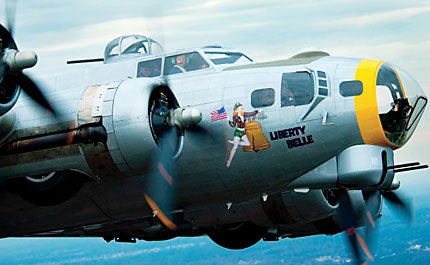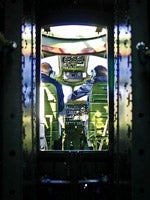60 Years After
General Paul Tibbets and Enola Gay navigator Dutch Van Kirk look back on one of the most famous moments in history
 Paul Tibbets joined the Army Air Corps at Fort Thomas, Ky., in 1937. In 1942, Tibbets joined the 97th Bomb Group in the Bolero Mission, ferrying B-17s, P-38s and C-47s from Bangor, Maine, across Greenland and Iceland to the European Theatre. He flew the B-17 Flying Fortress with the 340th Bomb Squadron Bombardment Group in Europe and later flew missions to support the Allied invasion of North Africa. In 1943, just six years after he learned to fly, Tibbets returned to the United States to become one of the few people in the world to be briefed on one of America's most highly guarded secrets---the Manhattan Project, led by nuclear scientist Robert Oppen-heimer. In August of 1945, Tibbets would fly the B-29 Super-fortress named after his mother, Enola Gay, to drop the world's first atomic bomb on Hiroshima, Japan. On August 10, the Japanese surrendered unconditionally, and World War II was over.
Paul Tibbets joined the Army Air Corps at Fort Thomas, Ky., in 1937. In 1942, Tibbets joined the 97th Bomb Group in the Bolero Mission, ferrying B-17s, P-38s and C-47s from Bangor, Maine, across Greenland and Iceland to the European Theatre. He flew the B-17 Flying Fortress with the 340th Bomb Squadron Bombardment Group in Europe and later flew missions to support the Allied invasion of North Africa. In 1943, just six years after he learned to fly, Tibbets returned to the United States to become one of the few people in the world to be briefed on one of America's most highly guarded secrets---the Manhattan Project, led by nuclear scientist Robert Oppen-heimer. In August of 1945, Tibbets would fly the B-29 Super-fortress named after his mother, Enola Gay, to drop the world's first atomic bomb on Hiroshima, Japan. On August 10, the Japanese surrendered unconditionally, and World War II was over.
This past winter, Paul Tibbets turned 90 years old. Aviation entrepreneur Pat Epps invited Tibbets to Atlanta for a surprise reunion with surviving crewmembers of his B-17, the Red Gremlin, and his B-29, the Enola Gay. During the day, members of the Tibbets crew rode in the Liberty Belle, one of only 14 of the 12,000 B-17s manufactured that's currently flying. She was joined by Glacier Girl, a P-38 recovered from more than 260 feet of Arctic ice in Greenland and a restored C-47 in formation flights around Atlanta. Before the flight, Gen. Paul Tibbets and Dutch Van Kirk, navigator for both the Red Gremlin and the Enola Gay, took a moment to look back at their unique flying careers.
Theodore "Dutch" Van Kirk: When we were in Africa, Paul Tibbets got the idea we could cook chickens in the empty five-gallon gasoline cans. Paul went to work, and pretty soon, we were eating chicken every day instead of K-rations, which was a wonderful thing, especially with that gasoline garnish he put in there! This went on for a while, and we were running out of money because these Arabs were robbing us blind. So one of our guys named Sanders told the Arabs that if they'd give us all the chickens for free, he'd give them the B-17 for a chicken coop. So every night, we had a bunch of chickens in the bomb bay. Then we had to leave to go to a new base, and as we took off, we still had all their chickens. We were waving goodbye to all those Arab farmers that we had robbed and they were all shaking their fists at us....
Willy Titsworth was our gunner. His major claim to shame was that he peed on a general who later became the U.S. president. We were flying down from Europe to North Africa in the B-17. Eisenhower and his staff was on our airplane. Paul Tibbets was flying. Willy had to use the relief tube, but it wasn't working properly. Eisenhower was just standing in the wrong place at the wrong time.
At 2:15 a.m., on August 6, 1945, Paul Tibbets and Dutch Van Kirk took off from Tinian Island in the Pacific and were headed for Hiroshima, Japan. Van Kirk, the navigator, remembers that night.
 |
| Early in World War II, Gen. Paul Tibbets piloted a B-17 (left) named the Red Gremlin. With navigator Dutch Van Kirk, he flew a number of missions in the European Theatre and later flew in support of the Allied advance into Africa. Later in the war, the two would fly together in the Enola Gay to drop the world's first atomic bomb over Hiroshima, Japan. Sixty years after that historic moment, Tibbets and Van Kirk reunited to discuss the flight and to look at how they would like history to remember them. |
Van Kirk: We knew what we had on board. There weren't a lot of usual conversations. Some people slept. Paul took a nap. Tom Ferebee [the bombardier] slept a lot. You've got to understand, the navigator is the only guy working all the time. Everybody paid attention... Dick Nelson read a book, something about a prize fighter or something of this type. Everybody expects a lot of Hollywood. It wasn't. We just went up there and did our job.
After a seven-hour flight, Van Kirk had navigated the Enola Gay over the target just 15 seconds off their intended ETA. Tibbets climbed the aircraft to 30,700 feet and bombardier Tom Ferebee entered last-minute wind corrections into the Norton bomb site. Tibbets reminded his crew to put on the heavy Polaroid glasses they had been given to protect their eyes from the blast. At 9:15 a.m., the Enola Gay shuddered as it released the 9,000-pound payload. Tibbets immediately put the B-29 into a steep diving right turn to escape the effects of the eminent blast.
Robert Oppenheimer, the man who headed the U.S. development of the atomic bomb, had told Tibbets, "Your biggest problem may be after the bomb has left your aircraft. The shock waves from the detonation could crush your plane. I am afraid I can give you no guarantee that you will survive."
Paul Tibbets: I had my nose down, trying to maintain my speed and trying to get around. I was just bringing the nose of the airplane up on the horizon, and the whole thing lit up in pinks, blues and white. Oh, God, you never saw anything like it; it was instantaneous.
Van Kirk: You saw the white cloud hanging over the city. Underneath the cloud, the entire city was just covered with smoke and dust. It looked like a pot of boiling oil down there. The bomb vaporized the air and you could see the shock wave coming. Then suddenly, it felt like somebody hit the airplane with a telephone pole.
Airborne instruments determined the Enola Gay was 101â2 miles from the center of the blast and that the airplane had experienced a 2.5 G shock wave. In the movie Above and Beyond, Tibbets is credited with looking in awe over the ruins of Hiroshima and saying, "My God, what have we done?"
Tibbets:I've been credited with saying something like that, "What did we do?" But, no, I knew what the hell we did, and I wasn't of the nature to say that line. All we said was, "We looked for a big bang, and we got it."
Directly after the war, Japanese military officers were flown to the United States to visit American military bases to see how they operated to enable a smooth transition to the U.S. occupation forces that would be in charge of all Japanese bases. Tibbets remembers being at a gathering of officers from both sides when a Japanese man approached him.
 |
| A number of World War II aircraft flew in for Tibbets' surprise party, including the restored B-17 Liberty Belle and the P-38 Glacier Girl. |
Tibbets: This guy wearing a blue suit steps right up to me; he had a can of beer in his hand and said, "My name's Fuchida. Should we talk about it?" I did a take on that because Fuchida didn't mean anything to me. He said, "Oh, hell, man, I led the attack on Pearl Harbor. What do you say to that?" I said, "Well, you sure surprised us." He said, "Well, what the hell do you think you did to us?" Before the war, Fuchida had graduated from Harvard and spoke perfect English. He looked into my eyes and he said, "By the way, you did the right thing dropping the bomb. The Japanese would never have surrendered."
Now, 60 years after the first atomic bomb, Paul Tibbets and Dutch Van Kirk look back over that historic mission and the controversy that sometimes surrounds it. How would they like the world to look at what they did?
Van Kirk: Anybody who takes the trouble to study the bomb and why we did it can only conclude that we saved more lives than the bomb killed. Remember, there were about 5,000 people being killed over there every day---5,000 a day. Anybody who studied the facts and knows what the situation was can only conclude that dropping the bomb was the right decision.
Tibbets: Based on personal experience, I seldom go anywhere over the years when somebody doesn't come up to me and say, "I was scheduled for that invasion. You saved my neck."
And I'll say, "That's good news. I'm glad I could."
I want to be remembered as a man who was given a job and who did it. No explanation, no nothing. I was given a job, and I just happened to do it.
I've got my own thoughts about that moment, but they're fleeting. I always try to face the future instead.

Subscribe to Our Newsletter
Get the latest Plane & Pilot Magazine stories delivered directly to your inbox






